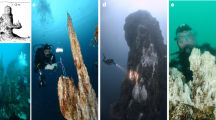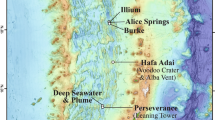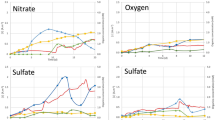Abstract
Hot, anoxic fluids emerging from deep-sea hydrothermal vents mix suddenly with cold oxygenated sea water, providing ideal microbial niches for organisms that need limited amounts of oxygen. We have now identified and grown the first microaerophilic, thermophilic eubacterium from a deep-sea hydrothermal chimney. In view of the likely abundance of this type of microenvironment in hydrothermal structures, these newly discovered thermophilic microbes could constitute a large part of the microbial populations in seafloor hydrothermal systems.
Similar content being viewed by others
Main
In 1995, using the submersible DSV Nautile, we deployed an in situ growth chamber on the top of a hydrothermal vent at the Mid-Atlantic Ridge (Snake Pit, 23° 22′ N, 44° 57′ W). After deployment for 5 days (with an in situ chamber temperature between 70 and 25 °C), we extracted DNA from samples collected from the chamber. We amplified the genes encoding small-subunit ribosomal RNA (16S rRNA genes)1 by using the polymerase chain reaction, then cloned and screened them by restriction-fragment length-polymorphism analysis2.
Representatives of each clone type were completely sequenced (GenBank accession numbers AF068782–AF068824). Phylogenetic analysis revealed that about 13% of the sequences were closely related to Aquifex3 (Fig. 1). These new sequences formed a separate clade from the Aquificales lineage, and grouped most closely with bacterial sequences from terrestrial geothermal springs in Japan4 and Yellowstone National Park5,6; this clade has previously had no representatives in culture.
Maximum-likelihood analysis was done using fastDNAml (version 1.1), distributed by the Ribosomal Database Project11, and the archaeal domain was used as the outgroup. Bootstrap analysis was performed with 100 resampled data sets; only values relevant to EX-H1 are presented.
Environmentally derived 16S rRNA gene sequences may indicate the microbial diversity of an environment, but they tell us little about the physiology and ecology of the organisms themselves. The similarity of our Mid-Atlantic Ridge 16S rRNA sequences to those of the Aquificales persuaded us to try a mixture of hydrogen and oxygen for enriching the population of Aquifex -like thermophilic chemolithotrophs (organisms that use inorganic substrates for energy recovery) during a research cruise in 1999 to another hydrothermal vent field at 9° N 104° W. Conservation of physiology over such a phylogenetic depth is unusual among thermophiles, although this is seen in methanogens.
We collected sulphide chimneys from onboard the DSV Alvin and ground the samples under an atmosphere of nitrogen. The rock slurry was inoculated into a modified MSH medium (http://caddis.esr.pdx.edu/OCM/) with a headspace containing 1 atmosphere CO2, 0.05 atmospheres O2 and 1 atmosphere H2, and the cultures were incubated at 70 °C. We isolated a highly motile, short rod from one of these enrichment cultures and named it strain EX-H1. Strain EX-H1 grew in the presence of 5% (by volume) O2, but did not grow well at 10% O2. The strain also grew anaerobically with nitrate as its sole electron acceptor, like most Aquificales, and did not grow at 95 °C.
We extracted genomic DNA, amplified the 16S rRNA gene and sequenced both strands (GenBank accession no. AF188332). The 16S rDNA sequence was about 78% similar to that of Aquifex pyrophilus, and 92% similar to the Mid-Atlantic Ridge deep-sea microbial sequences we obtained in 1995. On the basis of sequence alone, strain EX-H1 can be considered as a member of a new family or order7, separate from, but most closely related to, the genus Aquifex .
To our knowledge, this is the first report of a microaerophilic, hydrogen-gas-oxidizing, chemolithotrophic and thermophilic eubacterium from deep-sea vents. Although this new isolate is only distantly related to Aquifex, it shares with the Aquificales the ability to grow under microaerophilic conditions. The steep chemical and oxygen gradients at hydrothermal vents provide ample habitats at low-oxygen tensions that contain reduced substrates such as hydrogen gas. Microaerophiles such as EX-H1 and the archaeum Pyrolobus fumarii8 are therefore uniquely suited to these environments and, like the anaerobic ammonium oxidizers9, they can put the H2, CO2 and small amount of O2 available at deep-sea hydrothermal vents to good use.
If, based on their much-debated deeply rooted position in the tree of life9, the Aquificales-like microbes represent living fossils in the bacterial domain, then microaerophily may reflect an ancient metabolic trait. The early Earth had a reducing atmosphere, but small amounts of oxygen may have been available, initially produced photolytically by abiotic reactions and later by oxygenic photosynthesis. These initial low-oxygen conditions provided a selective pressure for the evolution of microbes capable of using oxygen, but without selection for tolerance of the higher oxygen concentrations present in the atmosphere today, thus favouring microaerophile survival. Alternatively10, the use of oxygen as an electron acceptor may have arisen through lateral gene transfer. The diversity of microbes being discovered must contribute to global biogeochemical cycling.
References
Ward, D. M., Bateson, M. M., Weller, R. & Ruff-Roberts, A. L. Adv. Micro. Ecol. 12, 219–286 (1992).
Reysenbach, A. L., Wickham, G. S. & Pace, N. R. Appl. Environ. Microbiol. 60, 2133–2119 (1994).
Aragno, M. in The Prokaryotes (eds Barlows, A. et al.) 3917– 3933 (Springer, New York, 1990).
Yamamoto, H. et al. Appl. Environ. Microbiol. 64, 1680– 1687 (1998).
Hugenholtz, P. et al. J. Bacteriol. 180, 366– 376 (1998).
Reysenbach, A. L. et al. Biol. Bull. 196, 367– 372 (1999).
Devereux, R. et al. J. Bacteriol. 172, 3609– 3619 (1990).
Blochl, E. et al. Extremophiles 4, 14–21 (1997).
Strous, M. et al. Nature 400, 446–449 (1999).
Doolittle, R. F. Nature 392, 339–342 ( 1998).
Maidak, B. L. et al. Nucleic Acids Res. 27, 171– 173 (1999).
Author information
Authors and Affiliations
Corresponding author
Rights and permissions
About this article
Cite this article
Reysenbach, AL., Banta, A., Boone, D. et al. Microbial essentials at hydrothermal vents . Nature 404, 835 (2000). https://doi.org/10.1038/35009029
Issue Date:
DOI: https://doi.org/10.1038/35009029
This article is cited by
-
Genome diversification in globally distributed novel marine Proteobacteria is linked to environmental adaptation
The ISME Journal (2020)
-
The microbiomes of deep-sea hydrothermal vents: distributed globally, shaped locally
Nature Reviews Microbiology (2019)
-
Cryogenian magmatic activity and early life evolution
Scientific Reports (2019)
-
Sediment Microbial Diversity of Three Deep-Sea Hydrothermal Vents Southwest of the Azores
Microbial Ecology (2017)
-
Characterization of Bacterial Communities in Deep-Sea Hydrothermal Vents from Three Oceanic Regions
Marine Biotechnology (2016)
Comments
By submitting a comment you agree to abide by our Terms and Community Guidelines. If you find something abusive or that does not comply with our terms or guidelines please flag it as inappropriate.




